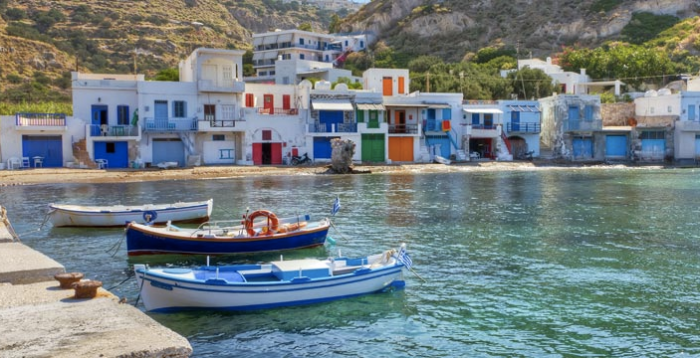52 eyelands: a genre-busting guide to the Greek Islands
Here’s a couple of tiny snippets from the start of his ‘sentimental journey through the Greek islands’.
Kythnos
Kythnos is not the first hat (or car) that an ordinary salesperson would bring out for you to see. He would want to show you some flashier models first, because that’s how he learnt to do things. In the same way, no travel guide for the Greek islands starts off with Kythnos – no one would even think of beginning with this island.
Kythnos is not the first hat (or car) that an ordinary salesperson would bring out for you to see. He would want to show you some flashier models first, because that’s how he learnt to do things. In the same way, no travel guide for the Greek islands starts off with Kythnos – no one would even think of beginning with this island.
Milos
Milos is rather known because of a wonderful statue, Aphrodite of Milo (Venus de Milo), which ironically, you will never see in the island. You will have to go to the Louvre. Let us return to the island now. There is no space to deal with thieveries of the past.
The tone of the book is relaxed and accepting of the traveller’s lot:
things may go awry from time to time, but that is to be expected.
Sometimes the ferry is late and the bus driver who is paid to meet it
gives up waiting and goes home to bed, and so the disembarking
passengers must reach their destinations on foot. But Papadoyiannis
makes light of such challenges. However bad the situation, he remains an
optimist. What you must do, he seems to be saying, is keep going, and
the next day you will find the good stuff.Milos is rather known because of a wonderful statue, Aphrodite of Milo (Venus de Milo), which ironically, you will never see in the island. You will have to go to the Louvre. Let us return to the island now. There is no space to deal with thieveries of the past.
Another positive thing about this project is, it is one of the first batch of books to be published by new Greek press, Paraxenes Meres, (Strange Days) which is just starting on its own travels – and on the strength of this book, an interesting journey may lie ahead.
Sustained throughout 52 eyelands is the voice of a travelling companion who is always careful not to tell you too much, always conscious that travel is about making choices and that since each traveller is different, each has discoveries of their own awaiting them on the islands he knows and loves so well.
At last: a no-spoilers guidebook. This could be a thing.
LANE ASHFELDT
http://pxl8.net/2013/08/30/52-eyelands-by-gregory-papadoyiannis/
Lane Ashfeldt is the author of SaltWater (Liberties Press, 2014) a collection of a dozen short stories and a novella (“An impressive debut collection” The Incubator). Other stories by Lane have appeared in anthologies and magazines, among them Dancing With Mr Darcy, Guardian.co.uk, Identity Theory, Punk Fiction, Southword, The Bohemyth, and The London Magazine. Visit Lane online at: ashfeldt.com

.JPG)

















